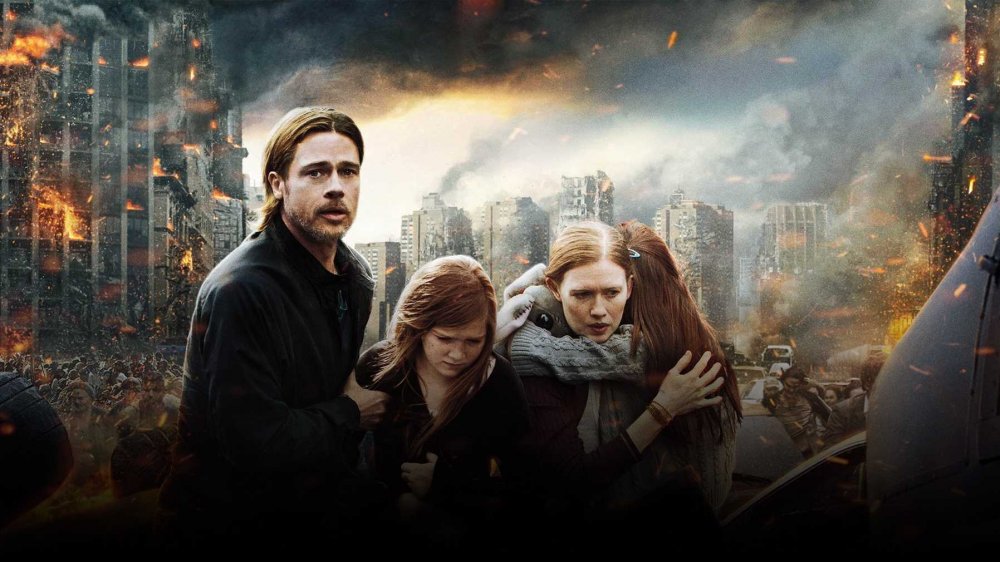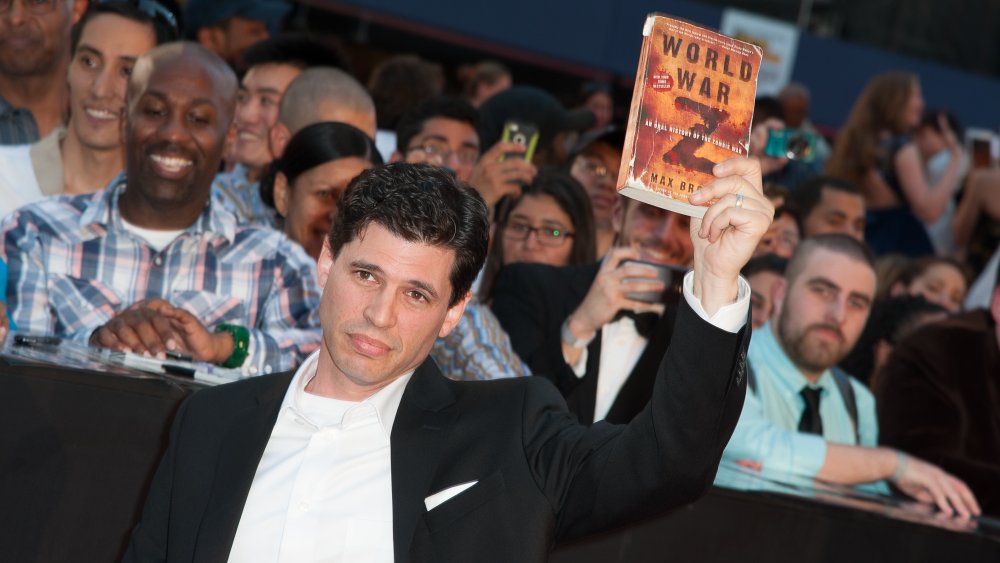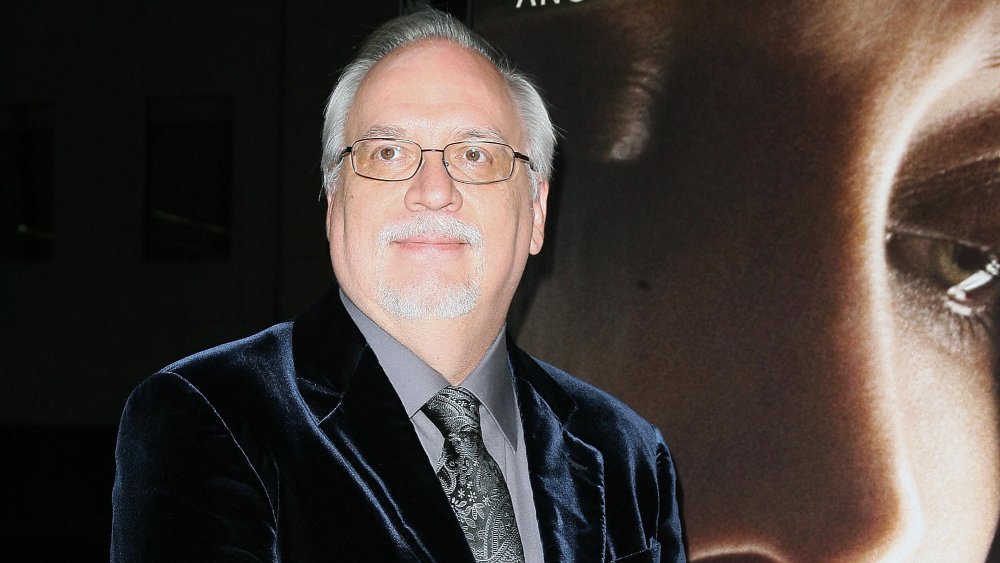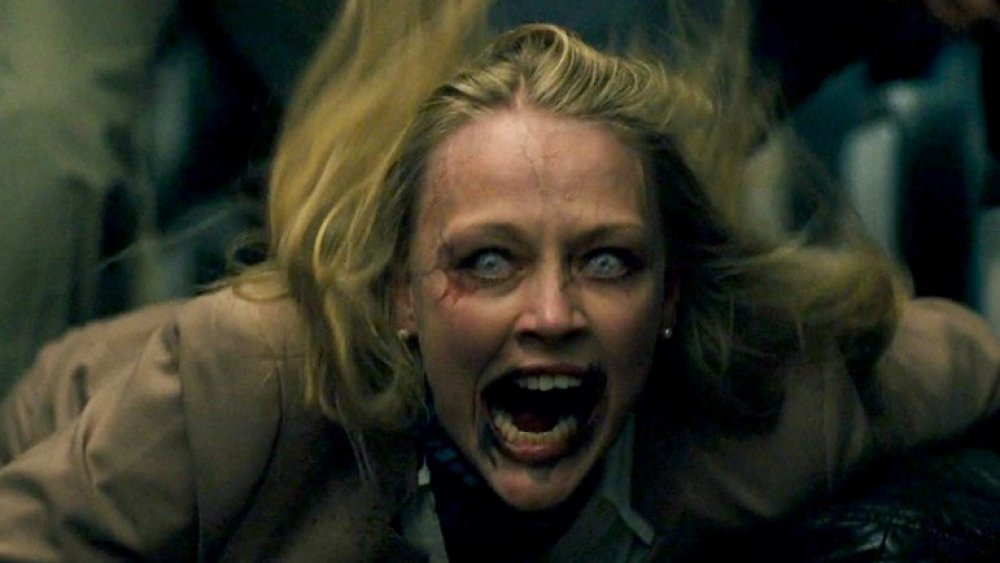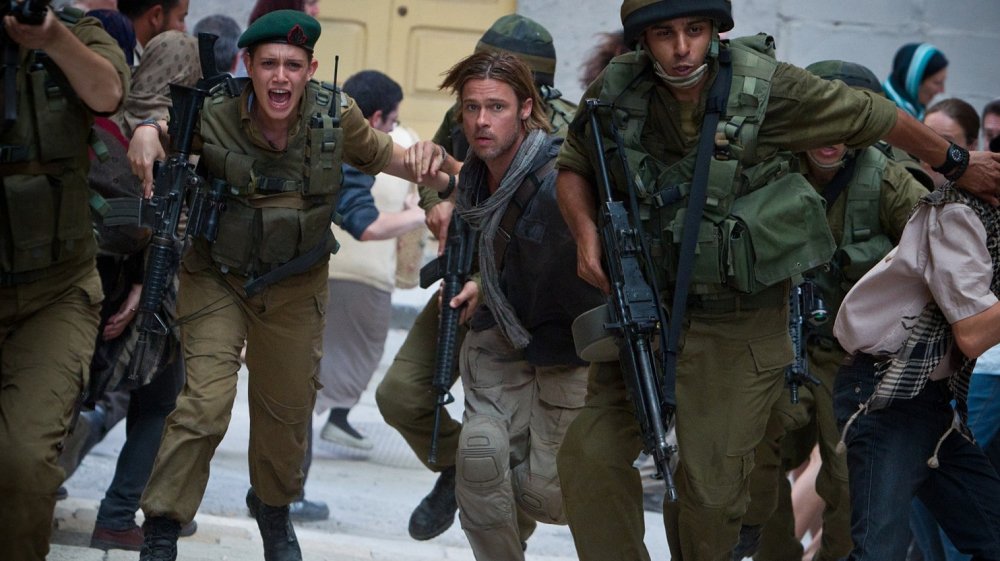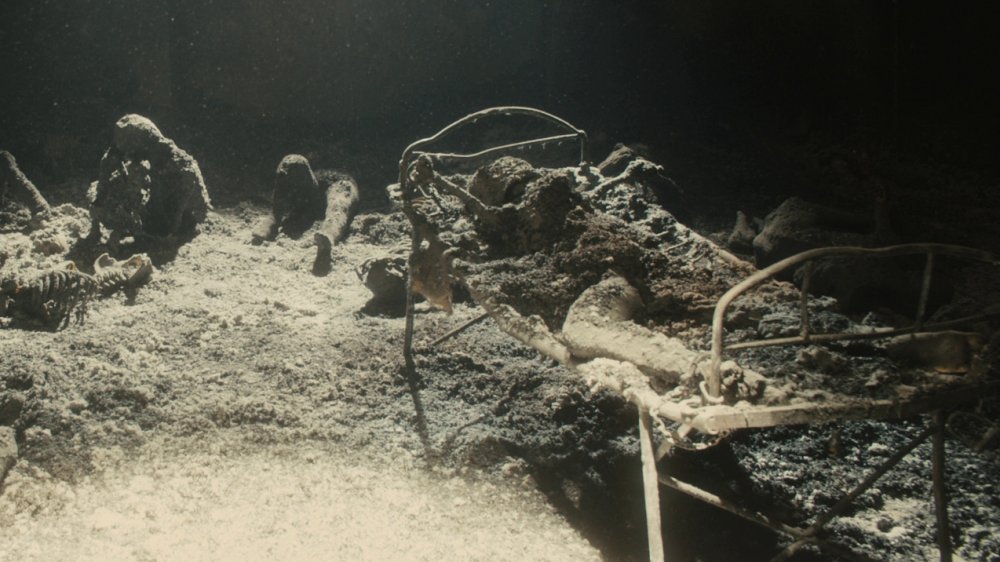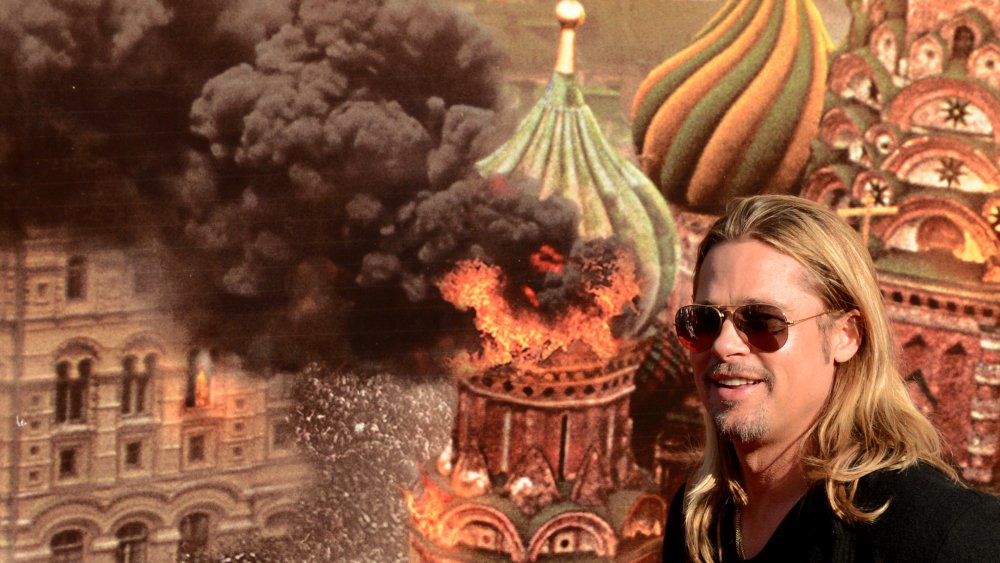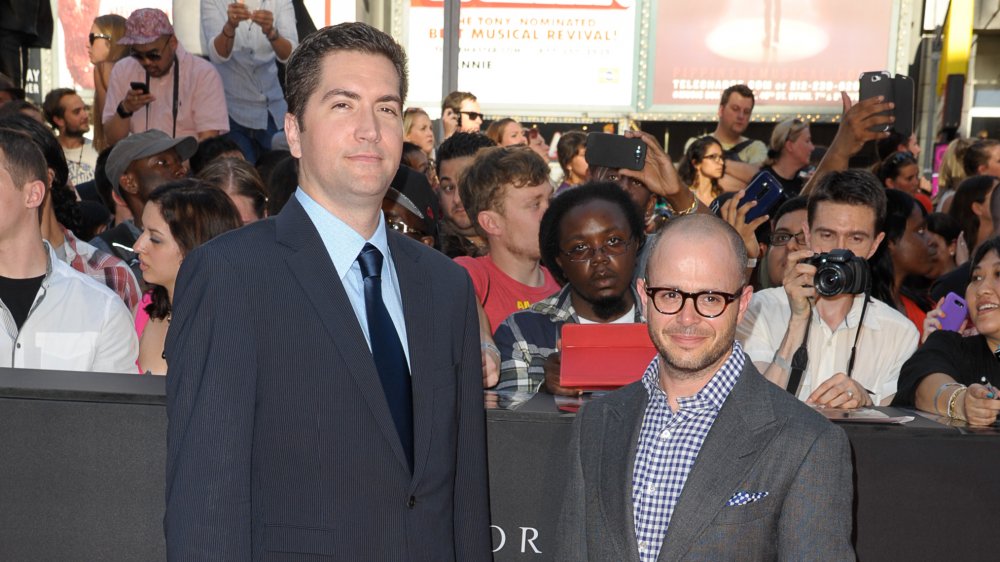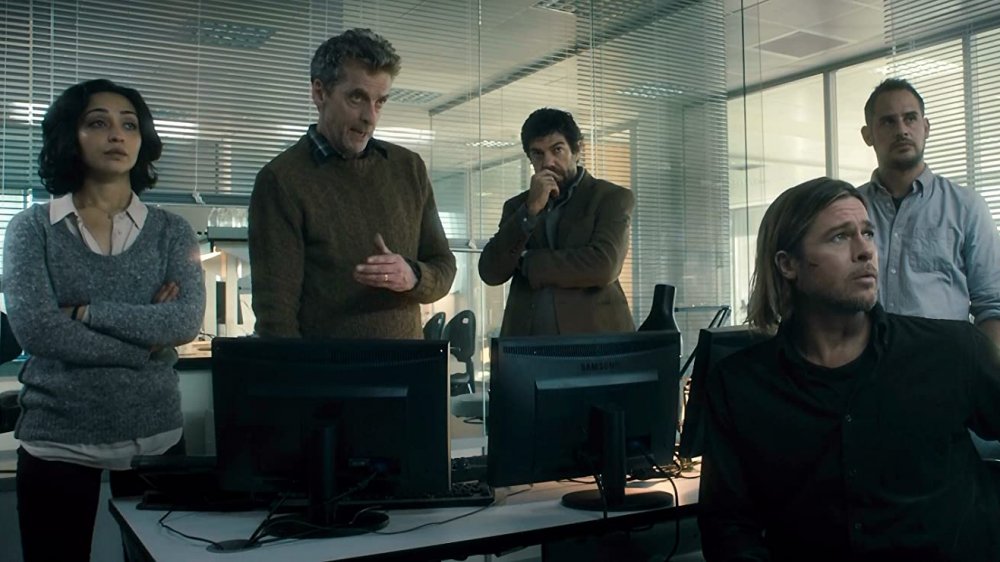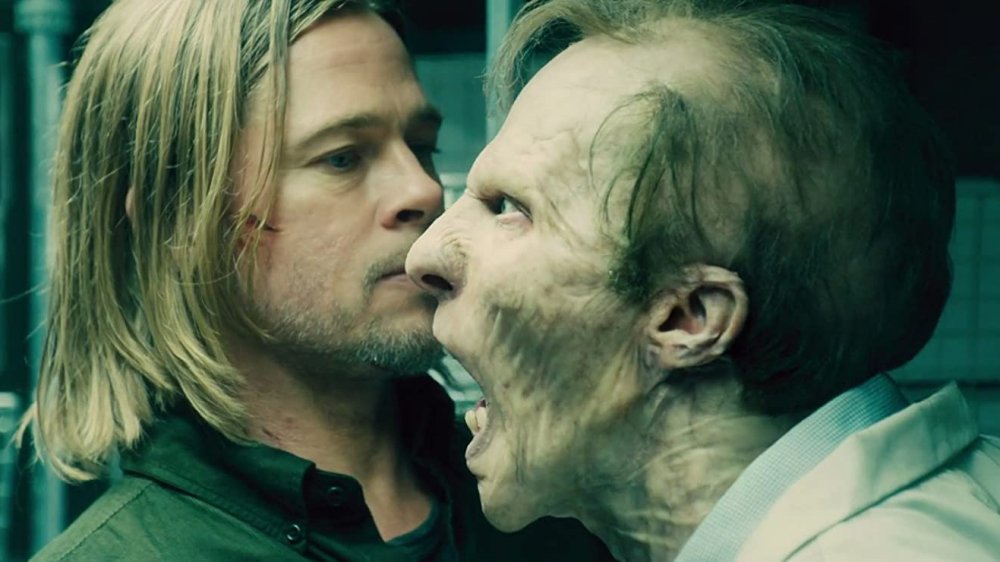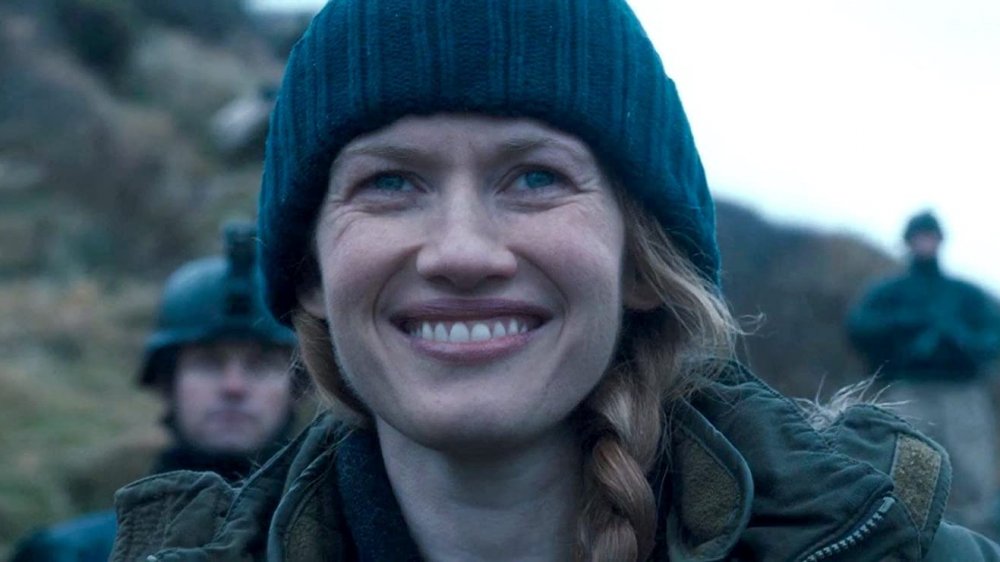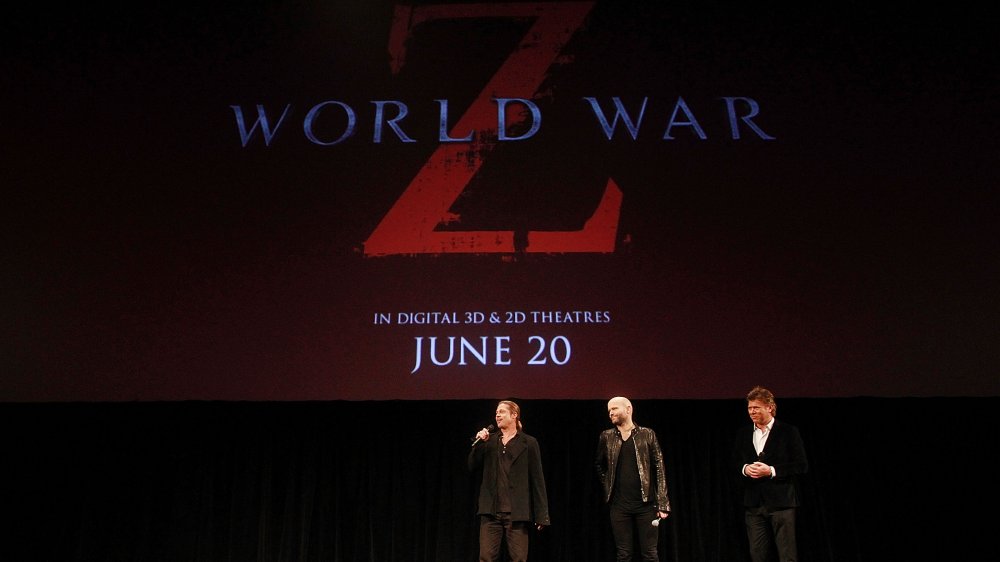The Ending Of World War Z Explained
Ever since George Romero essentially set the template with his 1968 horror classic The Night of the Living Dead, pop culture has served up so many zombies that it might seem that every angle on reanimated corpses had been explored. When author Max Brooks brought us World War Z in 2006, however, he injected new life into well-trod territory by offering up a global after-the-fact perspective on the kind of apocalyptic outbreaks usually related through ground-level narrative. The book, portrayed as an oral history from survivors of mankind's all-out battle against annihilation by shambling zombies, was a critical and commercial success...which, of course, made it ripe for filmic adaptation.
Enter Brad Pitt and his Plan B Entertainment production company. When Paramount purchased the rights to Brooks' book for the A-list actor, fans were understandably excited about World War Z's prospects on the big screen. When the film finally arrived in theaters, however, the finished product bore little resemblance to its source material, presenting a Pitt-led action thriller with ghoulish monsters who attacked in sprinting waves. This, after a production cycle that saw rewrites, reshoots, and an entirely re-envisioned third act. Audiences embraced it, but those who were hoping for a faithful adaptation of Brooks's work were left wondering how exactly they'd gotten here.
This, then, is a look back at the ending of World War Z — and how it went from prized source material to hailed script to problem production to box office hit.
Dawn of war
After the success of his 2003 how-to manual The Zombie Survival Guide, Max Brooks decided to take his love of the walking dead up a notch. Using his own work's version of the zombie "rules" (themselves inspired by the Romero canon, which established elements like zombies' slow gait and vulnerability to headshots) and drawing inspiration from Studs Terkel's oral history of World War II, he crafted a harrowing novel set in the era after the outbreak of a virus that reanimates corpses and nearly wipes out the human race. In it, a member of the UN Postwar Commission travels to locations around the world, conducting interviews that take the reader from the first hot spots to the collapse of society to the darkest moments, when humanity finds a way to fight back.
Despite its after-action report format, the book is full of scenes of zombie terror, gripping political commentary, and creative ideas about the ways in which humankind would need to adapt in order to overcome a threat to its very existence. Audiences responded with great enthusiasm, and World War Z would top the New York Times bestseller list, eventually selling more than a million copies.
With that amount of success, World War Z was bound to be a hot commodity when it came to film rights... but who would take on the challenge of adapting this unconventionally structured effort?
Battle plans
After a bidding war with Leonardo DiCaprio's Appian Way, Brad Pitt and Plan B got busy bringing Max Brooks' vision to the screen. They brought on J. Michael Straczynski, a veteran comics creator and the mind behind cult classic TV show Babylon 5, to write the script. Straczynski set to work crafting a screenplay that would draw inspiration from thrillers like The Bourne Identity, retaining much of the book's political emphasis and international scope.
Straczynski was a much-loved name in genre fan circles, and his work on World War Z touched a nerve with exactly that audience. A leaked version of the script made its way into the hands of the film nerds at Ain't It Cool News, where it was called Oscar-worthy by that site's Drew "Moriarty" McWeeny. Comparing it in scope to the Academy Award-nominated apocalyptic thriller Children of Men, McWeeny offered up the description of a script that kept the book's interview-based structure, painting a picture of a post-war world in which people are "starting to wonder if survival is a victory of any kind."
Straczynski's script also ended up on the 2007 Black List, an annually compiled survey of the film industry's favorite as-yet-unproduced screenplays. With that kind of momentum behind the project and director Marc Forster — a veteran of the James Bond franchise and critically acclaimed dramas like Monster's Ball — on board, the stage seemed set for World War Z to be a new kind of zombie movie: Serious-minded, and perhaps even award-worthy.
What could go wrong?
Transformation
The first signs of trouble appeared in 2009, when Marc Forster revealed that the script would be undergoing a rewrite from Matthew Michael Carnahan, whose previous works included The Kingdom and State of Play. Despite rosy statements from Max Brooks, who wasn't given input throughout the screenwriting process, word around the lot was that the rewrite came as the result of a clash between Forster and J. Michael Straczynski, with the former preferring a more action-oriented focus than what was present in the latter's script.
Carnahan's script changed things dramatically. Instead of taking place, as the book does, in the aftermath of the Zombie War, this new version put us, and Brad Pitt's Gerry Lane, squarely in the middle of the zombie apocalypse right from its earliest days. The focus was placed more on action and the Lane family's struggle to survive, rather than on the larger political and social implications of an all-out struggle against human extinction. Lane would still visit several locations around the Earth, from South Korea to Israel to Newark, N.J., but instead of interviewing those who'd been through the worst of the situation, he'd be experiencing it firsthand.
With this new script in the works, principal photography kicked off in July of 2011, but the change in focus would hardly be the last hurdle the production would face.
Reshoot for the head
From the jump, World War Z seemed a bit cursed. Several high-profile names, including Ed Harris and Bryan Cranston, were in, then out. Marc Forster and Brad Pitt's relationship soured over time, with the director, new to blockbuster action after a career focused on dramas, muddling on decisions such as how the film's zombies would be portrayed onscreen, eventually settling on sprinting waves of snarling ghouls rather than the book's more traditional form. Hungarian counterterrorism teams raided a warehouse in which the production was storing 85 guns meant to use as props during a portion of its shoot meant to take place in Budapest, because the weapons hadn't been cleared with the national government. Basically, it was kind of a mess.
The biggest issues, however, arose with the film's third act. Shooting began before the script was completed, and as it progressed, studio executives expressed reservations with the ending at which Forster arrived. Heavy on action and dark bordering on bleak, it definitely showcased the movie's ballooning budget, but left both studio executives and the creative team thinking something was missing. The problem is, this conclusion wasn't reached until said ending had already been shot, and rough cuts were being reviewed.
Patient Zero
So, why all this hubbub about the story's ending? Well, the book's ending is a bit nebulous. In it, humanity, after abandoning large portions of several land masses to the walking dead and retreating to various "Safe Zones," discovers that it must re-envision itself. Industry is retooled to facilitate the war effort, and military weaponry and tactics are completely overhauled to deal specifically with the kind of threat posed by a horde of shuffling, cannibalistic corpses — goodbye shock and awe; hello headshots. The book's climax sees various governments, including that of the United States, waging an all-out offensive to retake territory that had previously been overrun, reclaiming the world for the living.
As is so often true in life, though, things are a little messier than that. The undead threat never completely goes away. Zombie-ism is never "cured." The geopolitical ramifications of so many millions dying, of governments changing and reshuffling, are still being sorted out. The Earth's environment has been devastated due to nuclear conflict in the early days of societal breakdown and rampant and unchecked fires. Life for those who've survived humanity's near extinction is harder than it used to be, with the only note of hope being that we, as a species, stared down our own annihilation and beat it back.
It's... not exactly Hollywood blockbuster material.
The Russian front
So what was so problematic about Carnahan's take? Well, after a globetrotting adventure trying to get ahead of the zombie pandemic, Pitt's character ends up on a passenger plane escaping from an overrun Israeli settlement. Headed to Moscow, the flight crash-lands in Russia, where Pitt and the survivors are rounded up and conscripted into a zombie-fighting force... except for the elderly and infirm, who are summarily executed. The story then takes a leap forward, and finds Lane a hardened member of a battle-tested team tasked with clearing the tunnels of Moscow, making use of the "Lobo," a melee weapon showcased in the book. Included in this segment was a massive battle taking place in Moscow's Red Square.
Over the course of this conflict, Lane, now a hard-nosed, zombie-slaying badass, notices that the zombies appear susceptible to cold, and uses this tactic to gain the upper hand in the battle. He attempts to relay this information to his wife, but she's stuck in the Florida Everglades, and also in a relationship with a soldier played by Matthew Fox, whose part was reduced to more or less a walk-on in the final cut. Lane decides he has to reunite with his family, and the film ends with him leading a massive, D-Day-style invasion on the Oregon coast, kicking off a fight to reclaim the United States that would have been featured in a sequel.
A new hope
The ending was massive, and set the story up to launch a franchise, but just about everyone who reviewed rough cuts, from studio executives on down, felt the shift from the everyman Pitt played through the first two-thirds of the movie to what amounted to an '80s-style action hero in the last third was abrupt and emotionally unsatisfying. What's more, the fact that his family is fractured and still separated by the time the credits roll left viewers cold.
Said reservations were so intense, in fact, that Damon Lindelof, of Lost fame, was brought in to ideate around changes to the third act (Lindelof would later bow out in favor of Drew Goddard). He offered Paramount two options: One made up of minor tweaks to up the emotional stakes, and one that changed just about everything after Lane leaves Israel. Surprisingly, the studio opted for the more drastic, and costlier, option. This, coupled with seven weeks of reshoots during which Forster and Pitt were no longer on speaking terms, resulted in the budget of the film ballooning to a reported minimum of $190 million, harshing Paramount on the movie and resulting in a seven-month delay in its release.
Oh, and that troubled Budapest portion of the shoot? The majority of the 12 minutes of footage it yielded was dropped entirely. Oops.
World War act 3
So after all this back-and-forth, where did we end up? Instead of crash-landing in Russia, Lane's zombie-infested flight out of Israel heads for a World Health Organization facility in Wales. As it's coming in for a landing, however, the zombies threaten to overrun everything. Lane, in either a really brilliant or really dumb move, detonates a grenade that tears a hole in the fuselage and depressurizes the cabin, leading to all the zombies being sucked out (insert an "It's Raining Men" joke of your choice here) and the plane coming in for an intense crash-landing.
After a blackout, Lane, impaled by a rather large piece of shrapnel, wakes up in the wreckage and, along with Segen, makes his way to the W.H.O. outpost that was his initial destination. Overcome by his injuries, he loses consciousness, and later awakes under the care of a W.H.O. doctor played by Peter Capaldi (a billing that's led many to think the filmmakers were tipping off Capaldi's upcoming role as the BBC's best-known time-traveling alien). After regaining his senses, he comes to a shocking conclusion: Having seen the zombie horde pass by the sick and elderly, he believes that whatever virus causes the transformation drives its host to seek out only healthy and viable victims to facilitate its spread. Could this be the key to humanity's survival?
Pathogenius
Wouldn't you know it, a W.H.O. facility is just the place for Lane to test his theory that, by infecting one's self with a deadly — but curable — pathogen, it's possible to create a sort of "camouflage" that will cause zombies to ignore a potential victim. The only problem is that the lab containing the types of pathogens he needs is in the zombie-infested part of the building. In order to figure this all out and possibly save humanity, Lane and his companions have to embark on a sort of stealth mission, sneaking their way to a particular vault without alerting the dormant undead wandering the halls.
Here, we see the results of Lindelof and Goddard's effort to scale the action down to a more personal level. Rather than an epic battle, we're treated to a tense game of cat and mouse as Lane and company tiptoe their way toward the relevant vault. While they're eventually separated, Lane does get where he needs to go. Once he's there, however, he's trapped by a zombie blocking the exit... which is the perfect impetus for him to conduct the kind of experiment that only works in the movies. Injecting himself with an unknown pathogen, he then opens the door, only to find himself ignored by every zombie he encounters on his walk back to freedom.
War begun
That climax having happened, we then move into a denouement that dovetails somewhat back toward the larger geopolitical scope of the book. With Lane's theory proven correct, we see the distribution of an injectable "vaccine" brewed from a strain of meningitis to people around the world, as humankind begins to fight back. We see scenes of various battles, including some of the footage of the Moscow fight from the original cut's ending. Zombies are burned, evacuations are conducted, and a note of hope on a global scale is sounded.
True to the rework's purpose, however, the main focus remains personal, as Lane and his family are happily reunited in a safe haven in Nova Scotia. Pitt's voiceover speaks of a war just begun, but for his character, it seems the journey has ended in the best possible place, back together with his wife and daughters and out of harm's way.
Aftermath
To paraphrase the Grateful Dead, what a long, strange trip it was for World War Z, from bleak book to faithful adaptation to all-out war in the streets of Russia to a family brought together and a tide turned. With all this rigamarole, and with so many changes from the source material, would audiences respond?
Yes, they would: World War Z exploded to a box office take of $202.4 million domestically and $540 million worldwide, which were pretty great numbers for a film with such a troubled production history. It also clocked Pitt's biggest opening weekend, devouring $66.4 million in its first three days.
Unfortunately, this success didn't cure the contagion that plagued the property, as the sequel was scrapped after several stop-and-go efforts that included the signing of director David Fincher. Also apparently factoring in was China's ban on zombie movies, which crippled the potential for international revenue.
Still, despite its troubles, World War Z's success showed that audiences were hungry for more walking dead. Meanwhile, everyone involved emerged unscathed, with Pitt going on to arguably peak with 2019's Once Upon a Time... in Hollywood, Straczynski penning cult hit TV series Sense8, Forster directing Christopher Robin for Disney, and Damon Lindelof crafting one of 2019's top TV shows, Watchmen. Not bad for the crew behind a movie that, at certain points as it staggered to its ending, seemed like it would be dead on arrival.
